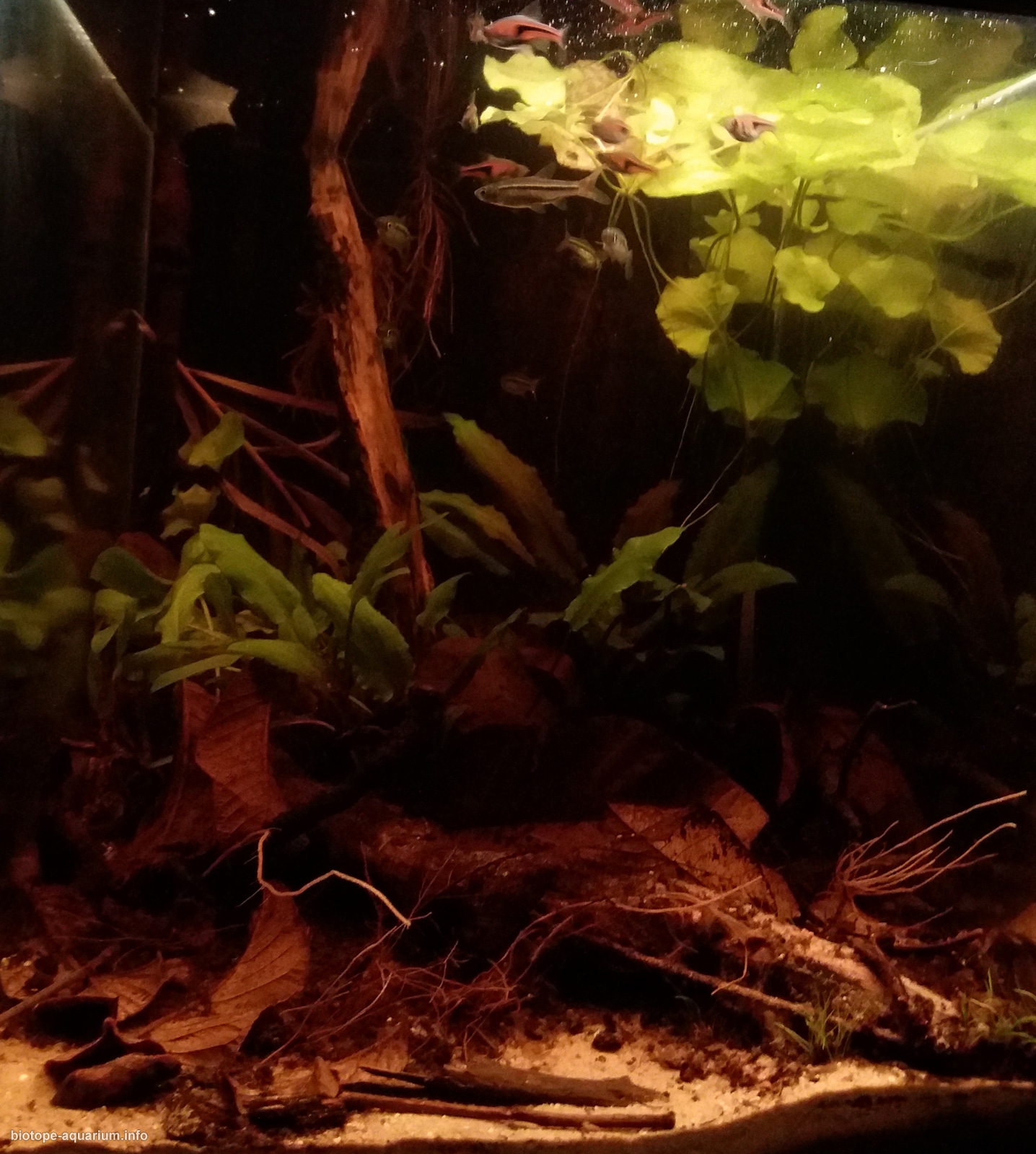Peat swamp forest in the eastern part of Malaysia, in Terengganu state
88th place in Biotope Aquarium Design Contest 2018
![]() Hungary. Daniel Szabó
Hungary. Daniel Szabó

Volume: 70 L
Dimensions: 35x40x50 cm
List of fishes: Rasbora borapetensis, Trigonostigma hengeli, Trichopsis pumila
List of plants: Nymphoides sp., Cryptocoryne sp., Eleocharis sp.
Description of decorations: The soil is mix true of sand and silt which is covered by fallen leaves, branches and roots. Beside the fallen leaves we can find some Cryptocorine sp. Colour of the water imitates the original habitat, brown .
Description of equipment: Filter: DIY, hanging filter, 150 L/h, Lighting: led.
Water parameters: Temperature 27 – 29°C, tds is 80ppm, pH 6, gh 2, kh 1.
INFORMATION ABOUT BIOTOPE
Description of the area surrounding the biotope: This aquarium would like to represent the eastern mart of Malaysian peat forests. The coustwis vegetation is groving densley, st contains swamp plants and trees in large number( Macaranga sp.,…).The peat is formed from debris of dead plants with biological, chemical and physical processes besides the water-covered and airles (anaerob) conditions.
Description of the underwater landscape of the biotope: The swamp is fed with precipitation, thus leachable tannins, humin acid make the water acidic and brown. The water movement is very slow. Leaves and driftwood lay on the ground of the aquarium scattered.
Description of the parameters of the habitat: Water hardness soft.Tds range between 20 – 130ppm. Average temperature is 27c and can reach until 30c in summer. Acidic condition where ph value can be as low as 4-6.
List of fishes and invertebrates occurring in the nature biotope: Rasbora borapetensis, Rasbora pauciperforata, Rasbora bankanensis, Sphaerichthys osphromenoides, Trigonostigma heteromorpha,Trigonostigma hegeli, Betta sp, Desmopuntius hexazona, Parosphromenus sp, Trichopodus leerii, Trichopsis pumila,Caridina sp.
List of plants found in the nature biotope: Nymphoides Aquatica, Cryptocoryne Affinis, Cryptocoryne Cordata, Cyptocoryne Schulzei, Cryptocoryne Nurii, Crytocoryne Purpurea, Barclaya Motleyi, Eleocharis sp.(cosmopolitan).
Threats to the ecology: In these rainforest the people have been living for thousands years. They have been farming more than 100 years, irspicte of it untile the beginning of the 20 thcentury, themain pat of the country was covered by tropical rainforest. Land reclination which was previously restricted to smallterritories, was burned by wood burning in the 1930’s by the large area of forest degradation. Due to the deforestation the dry peat becomes incerdiary and another forests can be destroyed by forestfire. The water of forest home so many endangered species (IUCN red list: Betta Persephone, Parosphromenus sp.). At the moment 60% of the country is covered we can find oil palm, rubber tree, cacao and coconut tree. In the remaining 8% we can find marshlands. Of the remaining estimated 300,000 hectares, now left in the Peninsula, about 67 % has been protected within Permanent Forest Reserves with theremainder in stateland forests.These virgin forests have wide range of diversity, they hom lot of endemic species like the Orangutan, Proboscis Monkey, Asian Elephant or Parosphromenus deissneri. Although the Malaysian and the Midle-European peat swamp ar so different, in my country, the peat swamp destroyed the agriculture and the animal breeding so since 2013 the leaves have bean protecting these places. Preparing for BADAC 2018I visited lot of peat swamp forest.
Sources of information:
• Malaysia’s Conservation and Sustainable Use Peat Swamp Forests published by the United Nations Development Programme (UNDP), Malaysia.
• Forestry Magazine (HUN) CXLI. Vol. Issue 3 (March 2006) – Forestry and Forest Management in Malaysia
• https://news.mongabay.com/
• http://www.iucnredlist.org/
